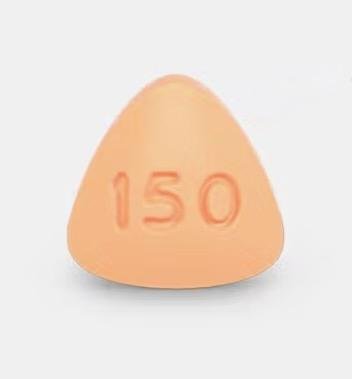Ojjaara Side Effects
Generic name: momelotinib
Medically reviewed by Drugs.com. Last updated on Jun 14, 2023.
Note: This document contains side effect information about momelotinib. Some dosage forms listed on this page may not apply to the brand name Ojjaara.
Applies to momelotinib: oral tablet.
Serious side effects of Ojjaara
Along with its needed effects, momelotinib (the active ingredient contained in Ojjaara) may cause some unwanted effects. Although not all of these side effects may occur, if they do occur they may need medical attention.
Check with your doctor immediately if any of the following side effects occur while taking momelotinib:
More common
- Black, tarry stools
- bladder pain
- bleeding gums
- bloating or swelling of the face, arms, hands, lower legs, or feet
- blood in the stools
- bloody or cloudy urine
- blurred vision
- chest pain or tightness
- confusion
- coughing up blood
- cough or hoarseness
- diarrhea
- difficult, burning, or painful urination
- difficulty in breathing or swallowing
- dizziness
- dizziness, faintness, or lightheadedness when getting up suddenly from a lying or sitting position
- fainting
- fast, slow, or irregular heartbeat
- fever or chills
- frequent urge to urinate
- headache
- increased menstrual flow or vaginal bleeding
- loss of taste or smell
- lower back or side pain
- muscle or body aches
- nausea or vomiting
- nosebleeds
- pale skin
- paralysis
- pinpoint red spots on the skin
- prolonged bleeding from cuts
- rapid weight gain
- red or dark brown urine
- sore throat
- stuffy or runny nose
- sweating
- tingling of the hands or feet
- ulcers, sores, or white spots in the mouth
- unusual bleeding or bruising
- unusual tiredness or weakness
- unusual weight gain or loss
Less common
- Blue lips, fingernails, or skin
- burning, numbness, tingling, or painful sensations
- decreased urine output
- dilated neck veins
- nerve pain
- swelling of the face, fingers, feet, or lower legs
- unsteadiness or awkwardness
- weakness in the arms, hands, legs, or feet
Incidence not known
- Anxiety
- chest discomfort
- dark urine
- difficulty in speaking
- double vision
- general feeling of illness
- inability to move the arms, legs, or facial muscles
- inability to speak
- loss of appetite
- pain, redness, or swelling in the arm or leg
- pain or discomfort in the arms, jaw, back, or neck
- pains in the chest, groin, or legs, especially the calves of legs
- persistent non-healing sore
- pink growth
- reddish patch or irritated area
- severe headaches of sudden onset
- shiny bump
- slow speech
- stomach pain, severe
- sudden loss of coordination
- sudden onset of slurred speech
- sudden vision changes
- swollen glands
- white, yellow or waxy scar-like area
- yellow eyes or skin
Other side effects of Ojjaara
Some side effects of momelotinib may occur that usually do not need medical attention. These side effects may go away during treatment as your body adjusts to the medicine. Also, your health care professional may be able to tell you about ways to prevent or reduce some of these side effects.
Check with your health care professional if any of the following side effects continue or are bothersome or if you have any questions about them:
More common
- Back pain
- burning, crawling, itching, numbness, prickling, "pins and needles", or tingling feelings
- itching skin
- pain in the arms or legs
Less common
- Feeling of warmth
- redness of the face, neck, arms and occasionally, upper chest
For Healthcare Professionals
Applies to momelotinib: oral tablet.
General
Serious adverse reactions occurred in up to 35% of patients and the most common of these reactions included bacterial and viral infections, hemorrhage, acute kidney injury, pneumonia, pyrexia, thrombosis, syncope, thrombocytopenia, and renal and urinary tract infection.[Ref]
Cardiovascular
Very common (10% or more): Hemorrhage (up to 22%), hypotension (up to 14%)
Common (1% to 10%): Thrombosis, arrhythmia, heart failure
Frequency not reported: Flushing[Ref]
Dermatologic
Very common (10% or more): Rash (up to 12%)[Ref]
Gastrointestinal
Very common (10% or more): Diarrhea (up to 22%), nausea (up to 20%), abdominal pain (up to 18%)
Common (1% to 10%): Vomiting[Ref]
Hematologic
Very common (10% or more): Thrombocytopenia (up to 28%)
Common (1% to 10%): Neutropenia[Ref]
Hepatic
Very common (10% or more): Elevated liver enzymes (up to 11%)[Ref]
Metabolic
Common (1% to 10%): Vitamin B1 deficiency[Ref]
Musculoskeletal
Very common (10% or more): Pain in extremity (up to 12%)
Common (1% to 10%): Back pain[Ref]
Nervous system
Very common (10% or more): Dizziness (up to 24%), headache (up to 11%)
Common (1% to 10%): Syncope, paresthesia
Frequency not reported: Neuralgia, peripheral neuropathy, peripheral motor neuropathy, polyneuropathy[Ref]
Ocular
Frequency not reported: Blurred vision[Ref]
Other
Very common (10% or more): Fatigue (up to 22%), bacterial infection (up to 21%), pyrexia (up to 12%), renal and urinary tract infection (up to 12%), peripheral edema (up to 11%)
Common (1% to 10%): Viral infection (excludes opportunistic infections)
Frequency not reported: Fungal infections (excludes opportunistic infections)[Ref]
Renal
Common (1% to 10%): Acute kidney injury[Ref]
Respiratory
Very common (10% or more): Cough (up to 14%)
Common (1% to 10%): Pneumonia, respiratory failure[Ref]
Frequently asked questions
More about Ojjaara (momelotinib)
- Check interactions
- Compare alternatives
- Pricing & coupons
- Reviews (1)
- Drug images
- Dosage information
- During pregnancy
- FDA approval history
- Drug class: multikinase inhibitors
- En español
Patient resources
Professional resources
Related treatment guides
References
1. Product Information. Ojjaara (momelotinib). GlaxoSmithKline. 2023;ORIG-1.
Further information
Always consult your healthcare provider to ensure the information displayed on this page applies to your personal circumstances.
Some side effects may not be reported. You may report them to the FDA.

